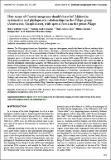Por favor, use este identificador para citar o enlazar a este item:
http://hdl.handle.net/10261/33282COMPARTIR / EXPORTAR:
 SHARE
BASE SHARE
BASE
|
|
| Visualizar otros formatos: MARC | Dublin Core | RDF | ORE | MODS | METS | DIDL | DATACITE | |

| Título: | How many of Cassini anagrams should there be? Molecular systematics and phylogenetic relationships in the Filago group (Asteraceae, Gnaphalieae), with special focus on the genus Filago. |
Autor: | Galbany-Casals, Mercè CSIC ORCID; Andrés-Sánchez, Santiago; Garcia-Jacas, Núria CSIC ORCID ; Susanna de la Serna, Alfonso CSIC ORCID ; Rico, Enrique; Martínez Ortega, M. Montserrat CSIC ORCID CVN | Palabras clave: | Bombycilaena Cymbolaena ETS Evacidium Evax Intraspecific sequence variation ITS Micropus Phylogenetic incongruence rpl32-trnL trnL-F |
Fecha de publicación: | dic-2010 | Editor: | International Association for Plant Taxonomy | Citación: | Taxon 59(6): 1671-1689 (2010) | Resumen: | [EN] The Filago group (Asteraceae, Gnaphalieae) comprises eleven genera, mainly distributed in Eurasia, northern Africa and northern America: Ancistrocarphus, Bombycilaena, Chamaepus, Cymbolaena, Evacidium, Evax, Filago, Logfia, Micropus, Psilocarphus and Stylocline. The main morphological character that defines the group is that the receptacular paleae subtend, and more or less enclose, the female florets. The aims of this work are, with the use of three chloroplast DNA regions (rpl32-trnL intergenic spacer, trnL intron, and trnL-trnF intergenic spacer) and two nuclear DNA regions (ITS, ETS), to test whether the Filago group is monophyletic; to place its members within Gnaphalieae using a broad sampling of the tribe; and to investigate in detail the phylogenetic relationships among the Old World members of the Filago group and provide some new insight into the generic circumscription and infrageneric classification based on natural entities. Our results do not show statistical support for a monophyletic Filago group. The traditional generic circumscription of most of the genera, as well as the traditional infrageneric classification of the genus Filago, do not correlate with the inferred phylogenetic relationships. A monophyletic circumscription of Filago and a new subgeneric treatment for this genus are proposed, this involving description of a new subgenus (Filago subg. Crocidion Andrés-Sánchez & Galbany, subg. nov.) and four new combinations (Filago subg. Pseudevax (DC.) Andrés-Sánchez & Galbany, comb. et stat. nov.; Filago discolor (DC.) Andrés-Sánchez & Galbany, comb. nov.; Filago gaditana (Pau) Andrés-Sánchez & Galbany, comb. et stat. nov. and Filago griffithii (A. Gray) Andrés-Sánchez & Galbany, comb. nov.). The genera Cymbolaena, Evacidium and Evax are synonymised under Filago. Several incongruences found between chloroplast and nuclear DNA sequence analyses, as well as a notable degree of intraspecific sequence variation in all regions sequenced are documented and discussed. | Descripción: | 19 p., Fot.col.; Supplementary Material: Figures S1–S4 are available in the free Electronic Supplement to the online version of this article (http://www.ingentaconnect.com/content/iapt/tax). | Versión del editor: | http://www.ingentaconnect.com/content/iapt/tax/2010/00000059/00000006/art00003 | URI: | http://hdl.handle.net/10261/33282 | ISSN: | 0040-0262 |
| Aparece en las colecciones: | (IBB) Artículos |
Ficheros en este ítem:
| Fichero | Descripción | Tamaño | Formato | |
|---|---|---|---|---|
| Galbany Casals al_ Filago group.pdf | 2,27 MB | Adobe PDF |  Visualizar/Abrir |
CORE Recommender
Page view(s)
314
checked on 22-abr-2024
Download(s)
636
checked on 22-abr-2024
Google ScholarTM
Check
NOTA: Los ítems de Digital.CSIC están protegidos por copyright, con todos los derechos reservados, a menos que se indique lo contrario.
